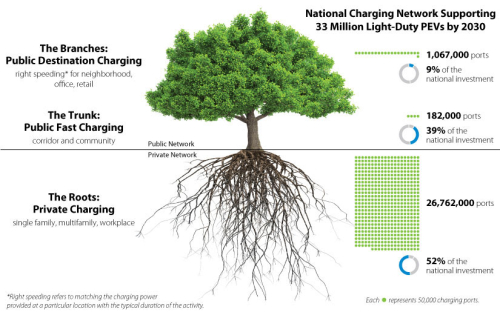Between ambitious federal clean energy policies, pledges by automotive companies to transition to zero-emission vehicles, and accelerating consumer demand for EVs, analysts have projected that by 2030, EVs could account for 30–42 million light-duty vehicles on the road. Now, NREL researchers have released The 2030 National Charging Network: Estimating U.S. Light-Duty Demand for Electric Vehicle Charging Infrastructure, a quantitative needs assessment for a national charging network capable of supporting the US transition to EVs.
The 2030 National Charging Network report finds that to support a mid-adoption scenario of 33 million EVs on the road by 2030, the nation will need 28 million charging ports. Because EV drivers strongly prefer the convenience of overnight charging, private residential chargers will form the core of the national ecosystem, but they will need to be complemented with reliable public fast charging.
Researchers project the national charging infrastructure will require:
182,000 publicly accessible fast charging ports to enable long-distance travel and ride-hailing electrification and to support those who lack access to residential charging.
1 million Level 2 charging ports at publicly accessible locations—including high-density neighborhoods, office buildings, and retail outlets.
8 million Level 1 and Level 2 charging ports at privately accessible locations—including single-family homes, multifamily properties, and workplaces.

The 2030 National Charging Network report’s research team created a new conceptual model to guide planning for a national EV charging network, captured in the infographic above. Image by NREL
The study was created in collaboration with the Joint Office of Energy and Transportation (Joint Office) and the US Department of Energy’s Vehicle Technologies Office. In turn, it will support the Joint Office’s work to deploy a network of EV chargers, zero-emission fueling infrastructure, and zero-emission transit and school buses nationwide.
As the Joint Office works with all 50 states, Washington, DC, and Puerto Rico to develop state- and community-level plans for EV charging infrastructure, the study’s findings will fuel the office’s vision of building a future where "everyone can ride and drive electric.
Estimating the EV charging infrastructure needs of an entire nation required NREL researchers to consider a vast array of data—from projecting drivers’ typical charging needs and EV adoption rates 7 years into the future to examining how different climates across the United States might affect energy requirements. The result is a framework with a level of detail focused on low-, medium-, and high-adoption scenarios where 30–42 million EVs drive US roads by 2030.
The study’s mid-adoption scenario considers 33 million vehicles on the road by 2030, according to NREL’s Eric Wood, a senior EV charging infrastructure researcher who led the study’s research team.
The framework we built for the 2030 National Charging Network study exhaustively considers how people in the US use light-duty cars to travel, what their energy needs are for that travel, and how we can meet those needs, given projected EV adoption rates. But what really makes the framework novel is the ability to create infrastructure estimates for specific locations using detailed transportation data. This enabled the team to answer questions like: How will EV adoption in neighboring states impact the demand for public fast charging along highway corridors in my area? And how might that out-of-state demand compare to charging needs from residents in my area?
Together, the study’s data create a snapshot of what we think an EV charging network would need to look like by 2030 to support 30–42 million passenger EVs.
—Eric Wood
Using EVI-Pro, Wood and the NREL team calculated the typical daily charging needs for running errands and commuting. The analysis considered energy demands for those who do and do not have access to convenient home charging.
Using EVI-RoadTrip, the researchers projected the charging infrastructure needed to make long-distance travel along national highways feasible.
Using EVI-OnDemand, the researchers estimated the charging infrastructure needed for ride-hailing fleets like Uber and Lyft to electrify their operations.
Using NREL’s Transportation Energy & Mobility Pathway Options (TEMPO) model, the team was able to estimate the number of EVs that might be on the road under different adoption scenarios.
Rather than creating a one-size-fits-all approach to charging, the study considers the realities of life across the United States: differences in weather, housing types, travel behaviors, and preferences in charging options.
The detailed region-specific analysis is now available to states and communities, who can break out the estimates for their area and use the data to guide local investments into EV charging infrastructure.
City-to-city differences in climate, travel patterns, housing, charging preferences, and demographics aren’t considerations captured in other infrastructure assessments that we've seen. We believe that making that data publicly available, and having it customized to each of these regions, will prove pivotal as cities work to determine their network needs.
—Eric Wood